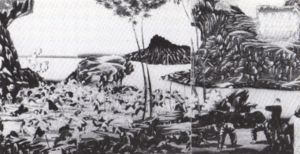
|
Japanese viewpoint |
| Ryukyu viewpoint |
| Ch'ing viewpoint |
| Aboriginal viewpoint |
Taiwan in December 1871. It marks the first overseas deployment of the Imperial Japanese Army and Imperial
Japanese Navy.
The Meiji government of Japan demanded that the Chinese government punish
leaders of the aborigines responsible for the murders Japanese foreign
minister Soejima Taneomi went to Beijing, and was received in an
 The Ryujo was the flagship of the Taiwan expedition. |
audience by the Qing Emperor Tongzhi (in itself a
diplomatic triumph); however, his request for compensation was refused on
the grounds that most of Taiwan was outside effective Chinese control.
Charles Le Gendre, the American military advisor to the Japanese government,
as well as Gustave Emile Boissonade, legal advisor, urged that Japan take
the matter into its own hands.
The Japanese government agreed, and sent an expedition of 3,600 soldiers led
by Saigo Tsugumichi in May 1874. The number of casualties for the Paiwan
tribesmen was about 30, and that for the Japanese was 543 (12 killed in
battle and 531 by disease).
Although overtly to punish the local tribesmen for beheading Okinawan
merchants, the Taiwan Expedition served multiple purposes for the new Meiji
government. In terms of foreign policy, it was intended to force formal
Chinese acknowledgment of Japanese sovereignty over the Ryukyu Islands, and
lack of effective control over Taiwan. It was
also a trial balloon to study the performance of the Japanese military in a future invasion of Taiwan. Domestically, the action also mollified those within the Meiji government who were pushing for a more aggressive foreign policy, and who were enraged by the government's refusal in 1873 to attack Korea. It is significant that the expedition took place shortly after the Saga Rebellion, and was led by Saigo Tsugumichi (Saigo Takamori's younger brother) and consisted largely of former Satsuma and Saga samurai.
 Soldiers of the Imperial Japanese Army in 1875. |
Japanese forces withdrew from Taiwan after the Qing government agreed to an indemnity of 500,000 Kuping taels.
Soon after the Japanese expeditionary force arrived on
Taiwan, it sought to establish military dominance over the aborigines
through a series of aggressive strikes. Newspaper articles and accounts of
the expedition by participants provide compelling evidence that the fighting
proved to be one-sided and short, if not exactly easy. The fighting began
when a group of aborigines ambushed a small Japanese scouting party on May
18. Using matchlock rifles, they shot to death two Japanese soldiers and, in
their tradition of headhunting, took the head of one of the Japanese dead
before they retreated into the mountains. Within a few days, Japanese forces
mounted a retaliatory strike, and on May 22 a major battle took place at a
ravine that the Japanese sources called Sekimon (literally, Stone Gate). The
Japanese suffered four killed and twelve wounded, while the aborigines
suffered seventy killed and wounded. In the samurai tradition, Japanese
soldiers took the heads of several of the dead, including the leader of the
Butan and his son. A few days
later, Saigo Tsugumichi ordered a major
assault on the people of Butan and Kusakut, the two villages suspected of
participating in the slaughter of the Ryukyuan castaways in 1871, and the
assault took place between June 1 and June 3. Following the recommendation
of his American military advisers, Saigo split the Japanese force into three
units: the first carried out a frontal assault against the Butan, the second
set out with a Gattling gun in tow to attack the Kusakut (impassable roads
compelled them to send the gun back to camp before they had traveled far),
and the third performed a flanking maneuver, proceeding north along the
coast before heading over the mountains to attack the Butan from the rear.
By the time the fighting ended, the villages inhabited by the Butan had been
burned to the ground, as had several other villages in the area, and the
Butan and Kusakut had been scattered. By the middle of July, the chiefs of
all the aborigine villages of southern Taiwan had presented themselves at
the expeditionary headquarters and "submitted" to Japanese authority.
Reference
http://en.wikipedia.org/wiki/Taiwan_Expedition_of_1874http://www.historycooperative.org/journals/ahr/107.2/ah0202000388.html
